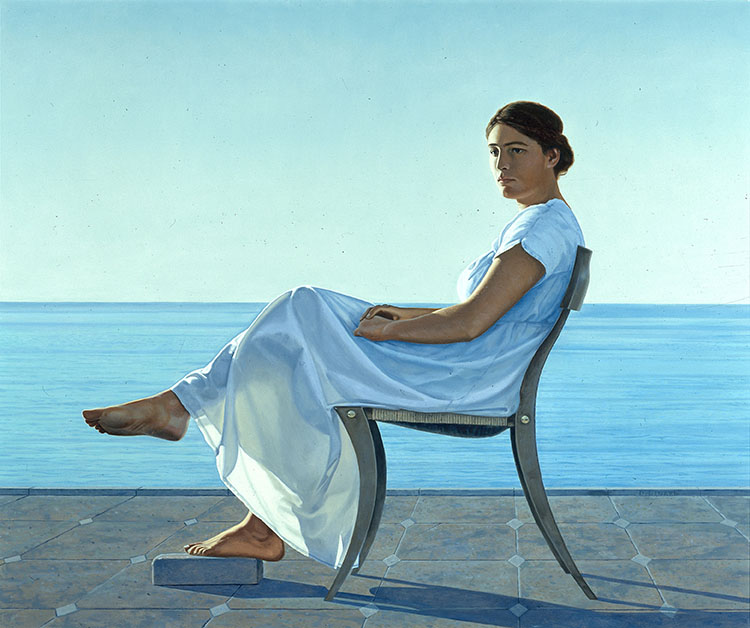
Interestingly, Ligare does not reject conceptual art, he absorbs it recognizing the primacy of “idea” while also acknowledging the importance of what he calls “visual literacy.”
“One of the most important functions of art now is to make sense of the world through careful and rational analysis and the perspective of history.”
David Ligare, Paintings
Catalog Introduction, 1997
This catalog is not so much a presentation as a proposition. It follows the exhibition of a selection of my paintings titled “Landscape & Language” at the Monterey Museum of Art in Monterey, California. That exhibition, like all my work for the past twenty years, sought to reconnect the viewer with what the artist and critic Sidney Tillim called “purposeful representation.”
In the exhibition and in this catalog, I am proposing an art that seeks to communicate specific ideas that knit us together through common historical knowledge. For me, it seemed especially appropriate to make this proposition in connection with the Monterey Museum, an institution that specializes in the unique history and profound beauty of this region.
In 1978, when I set my present course of trying to understand and to use the visual language of Greco-Roman history in my paintings, I consciously looked for stars by which to navigate. The two stars I chose among so many were Polykleitos, the fifth-century BC Greek sculptor from Argos, and Nicolas Poussin, the French artist who painted in Rome during the seventeenth century. The work of both of these artists represents images and ideas that have contributed greatly to what I call “recurrent classicism.”
Polykleitos’ most famous statue, the Doryphoros or Spearbearer, was a bronze figure that embodied the sculptor’s canon—a treatise on ideal proportion. More than that, however, it outlined the concept of symmetria, which did not mean balance as much as it meant the integration of the varied parts of the body by a system of mathematical proportions. Symmetria literally means “the commensurability of parts.” Polykleitos helped form one of the foundations of Western thought: that there is a substratum of harmonic relationships that underlies all nature and human social interaction. In other words, it isn’t just the individual members that are important, but the interrelationships between them.
Twenty centuries later, the painter Nicolas Poussin embraced much the same philosophy. The underlying structure in his paintings at times utilized the harmonic proportions of the Greek modes, or ancient musical arrangements. The hidden geometry of the picture became a visual equivalent of music that provided, according to Poussin, “a subtle distinction, particularly when all the things that pertained to the composition were put together in proportions that had the power to arouse the soul of the spectator to diverse emotions.”
This same proportional structure aligned and organized all of the lovingly realized elements depicted in Poussin’s paintings. Each figure, tree, and cloud had an integral relationship to the whole of the composition. Moreover, Poussin used these elements to tell stories that offered to the viewer moral and intellectual lessons. He often selected themes that suggested an individual’s potential for virtuous action.
When I began analyzing paintings like those of Poussin, I concluded that there was a fullness about them that could be broken down into three basic elements: structure, surface, and content. The structure included the geometric design and proportions, the surface was the look of nature reverently recreated with brush and paint, and the content was the theme or story whose purpose was to communicate a specific idea to the viewer. This tripartite criterion for a work of art has guided me ever since.
The richly beautiful landscapes of Monterey County, where I have lived for much of my life, provide the setting for most of my paintings. Because California actually looks so much like Italy, Greece, and Spain, and because its earliest European immigrants were from the Mediterranean, it seems fitting to substitute one for the other. Finding or inventing an ideal landscape and filling it with narratives or stories of human endeavor is once again new territory for the artist.
There has been widespread mistrust of classicism in the late twentieth century. It is believed by many to represent authoritarian or elitist ideas. In fact, the opposite is true. Art historian Andrew Stewart writes that the Spearbearer was viewed in its own time as “an ‘everyman’ free of individual peculiarities and quirks.” As I have said, it is an essay on physical and social integration—the diverse many coalesced into one. As the scholar Robert Proctor has written, “We can recognize that the ancient problem of the one and the many has come back to haunt us, and we can study the particular solutions to this problem worked out in antiquity.” It is extremely important to note that the canon of Polykleitos exactly coincided with the age of Pericles and the flowering of the world’s first democracy.
It is my strong belief that the classicism of ancient Greece possesses a fundamental relevance. That is why, despite its many “deaths” over the centuries, it has always returned. As I wrote for the University of Notre Dame in 1991, “Classicism was an amalgam of styles and ideas from the earliest and smokiest of times. It absorbed something from all of the cultures that it came into contact with, from Egypt and Africa to Asia, creating in the process an enormously inclusive rather than exclusive ideal.”
Polykleitos, Poussin, and many others provide us with a much-needed model for a new ideal. The new ideal that I propose is based on the classical model that is best represented by the Doryphoros. It includes the integration of diversity, virtuous community participation, reverence for nature, the radical pursuit of knowledge, and the embracing of the full implications of humanist beauty.
David Ligare
